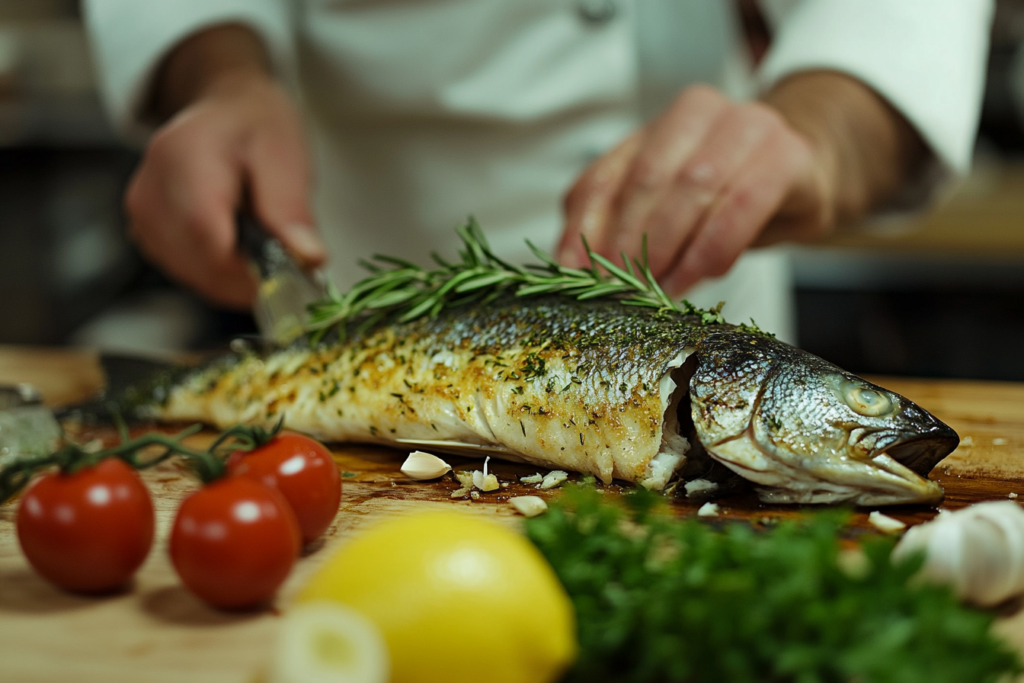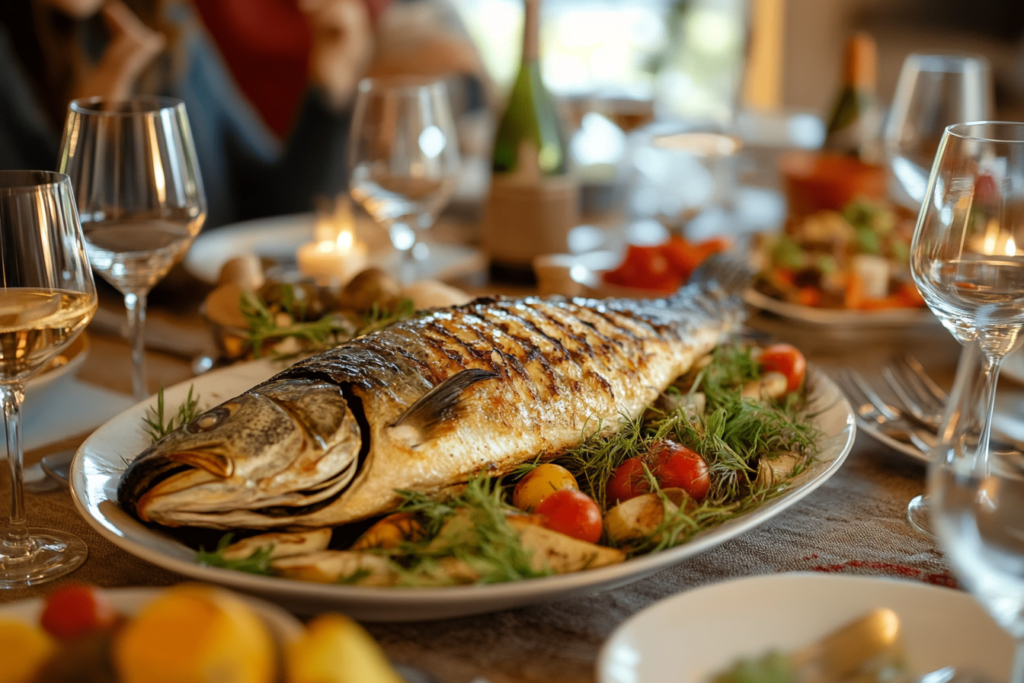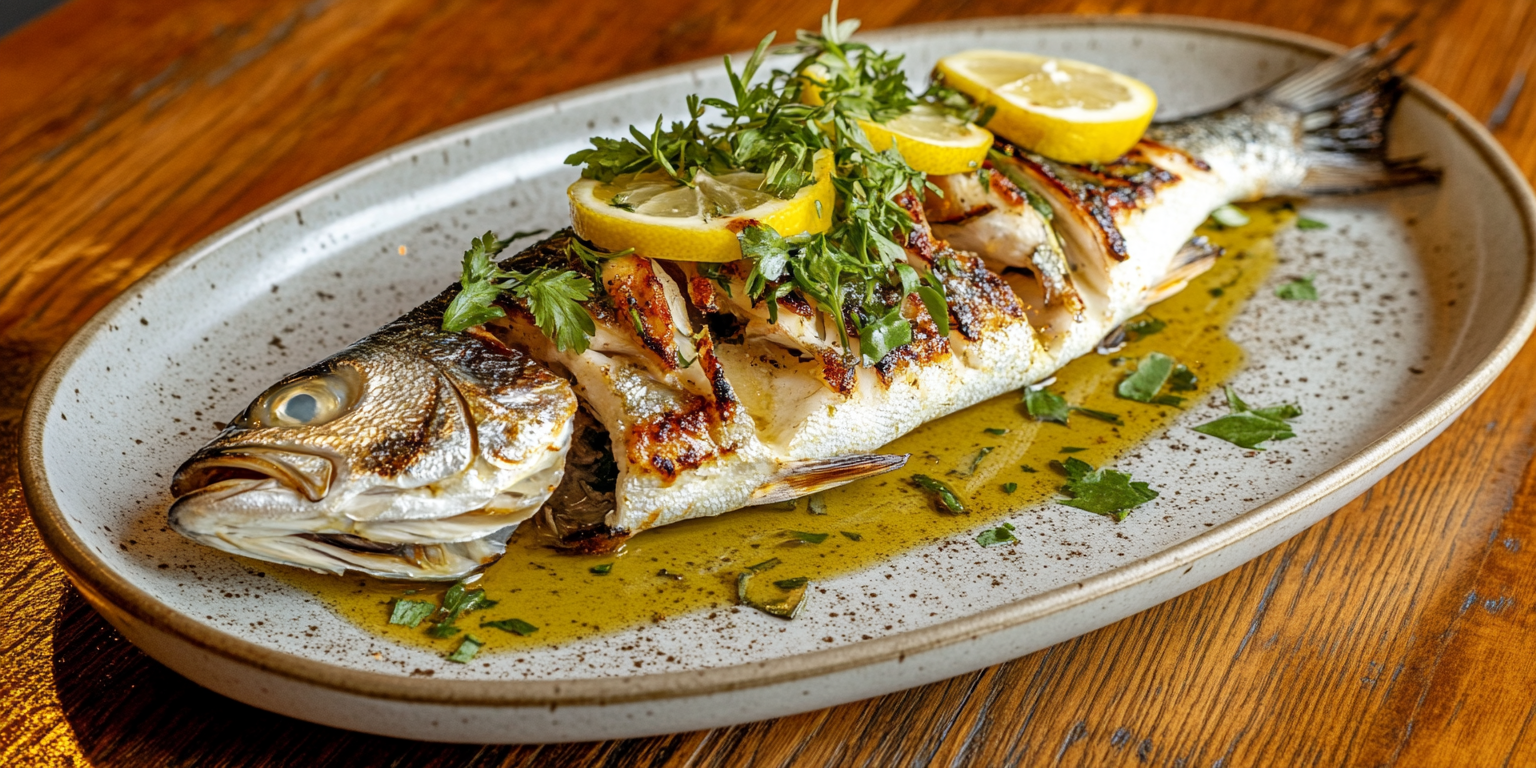Table of contents
What Kind of Fish is Branzino?
Branzino Fish: Origin and Popularity
Branzino, also known as European sea bass, is a well-loved fish that thrives in the Mediterranean Sea and the eastern Atlantic Ocean. Its popularity as a food dates back to ancient times. People in Mediterranean regions highly valued it during this period for its culinary uses. The fish’s mild flavor, firm texture, and versatility in cooking have made it popular worldwide.
As a result, branzino is now a key part of many coastal European dishes. It is also a favorite in fine dining restaurants across the globe. Furthermore, branzino’s charm lies in how well it pairs with a variety of herbs, spices, and cooking methods. This makes it a go-to choice for both chefs and home cooks.
Common Names for Branzino Worldwide
Branzino goes by different names around the world, which highlights its wide availability and importance in many cultures. For instance, Italians often call it “branzino” or “spigola,” while the French refer to it as “bar commun” or simply “bar.” The Spanish use the name “lubina,” and Greeks call it “lavraki.” In English-speaking countries, people commonly know it as European sea bass. Despite the variety of names, many recognize the fish for its unique qualities and high value. Moreover, it connects cuisines and cultures with its great taste and versatility.
Culinary Uses of Branzino Fish
Popular Dishes Featuring Branzino
Branzino is popular in many types of cooking for its light, tender meat and ability to soak up flavors from herbs, spices, and sauces. Some well-known dishes with branzino include Mediterranean-style whole roasted branzino, often filled with fresh herbs like rosemary, thyme, and parsley, and flavored with olive oil, garlic, and lemon. The Italian dish branzino al cartoccio (fish cooked in paper) brings out its mild taste with white wine, cherry tomatoes, and capers. In Greece, lavraki me ladi kai lemoni pairs grilled branzino with olive oil and lemon dressing. In Asian-style recipes, branzino is often steamed with ginger, green onions, and soy sauce, bringing out its natural sweetness while keeping the dish light and healthy.

Cooking Methods for Branzino: Grilling, Baking, Frying
Branzino’s versatility makes it suitable for a wide range of cooking methods:
- Grilling: Grilling branzino, whether as a whole fish or fillets, is a popular choice. The high heat caramelizes the skin, adding a smoky flavor while keeping the flesh moist and tender. Grilled branzino is often served with a side of vegetables or a fresh salad.
- Baking: Baking branzino is an effortless method that preserves its natural flavors. The fish can be baked whole, often stuffed with herbs and citrus for added aroma, or as fillets topped with a light crust of breadcrumbs and herbs for a crispy texture.
- Frying: Frying branzino, especially in the form of fillets, creates a crispy exterior while maintaining a juicy interior. Lightly battered or dusted with seasoned flour, fried branzino pairs beautifully with a tangy dipping sauce or a squeeze of lemon.
These cooking techniques showcase branzino’s adaptability, ensuring it remains a favorite in kitchens worldwide, whether for casual meals or sophisticated dining.
Nutritional Benefits of Branzino
Macronutrients in Branzino Fish: Protein, Fats, Carbohydrates
Branzino is a highly nutritious fish, offering an excellent source of essential macronutrients:
- Protein: A lean and high-quality source of protein, branzino is ideal for supporting muscle growth, repair, and overall bodily functions. Its protein content makes it a great choice for athletes, individuals on high-protein diets, or anyone seeking a healthy, low-fat protein source.
- Fats: While branzino is low in overall fat, it is rich in omega-3 fatty acids, which are beneficial for heart health, reducing inflammation, and supporting brain function. These healthy fats contribute to the fish’s reputation as a heart-healthy food.
- Carbohydrates: Like most fish, branzino is naturally carbohydrate-free, making it a suitable option for low-carb and ketogenic diets.
Micronutrients: Vitamins and Minerals
Branzino is also packed with a variety of vitamins and minerals essential for maintaining good health:
- Vitamins: It provides significant amounts of vitamin D, which supports bone health and immune function, and B vitamins, including B12, which is crucial for red blood cell production and neurological health.
- Minerals: Branzino is a good source of selenium, an antioxidant that helps protect the body from oxidative stress, and phosphorus, which plays a key role in bone and teeth strength. Additionally, it contains potassium, essential for regulating blood pressure and muscle contractions.
This combination of macronutrients and micronutrients makes branzino a nutritious addition to a balanced diet, offering a wealth of health benefits while being delicious and versatile.
Cultural Significance of Branzino
Branzino in Mediterranean Cuisine
Branzino plays a key role in Mediterranean cooking. People love it for its mild taste and ability to work well in many recipes. For instance, coastal areas of Italy, Greece, Spain, and Turkey often feature it in both daily meals and fine dining. Furthermore, its preparation often highlights the simplicity and freshness of Mediterranean cooking. Chefs commonly use olive oil, lemon, fresh herbs, and seasonal vegetables to enhance its flavor.
In addition, branzino closely supports a healthy diet and fits well into the Mediterranean diet, widely regarded as one of the healthiest in the world. Whether people grill it and drizzle it with olive oil or bake it with tomatoes and capers, branzino represents the best of Mediterranean cooking: fresh, simple, and full of flavor.

Festive and Traditional Occasions
Branzino also carries cultural and festive significance, often gracing the table during celebrations and special occasions. For example, in Italy, it is commonly served during Christmas Eve’s Feast of the Seven Fishes, a traditional meal featuring a variety of seafood dishes. Meanwhile, in Greece, branzino, or “lavraki,” is a popular choice for Easter feasts and family gatherings, symbolizing abundance and prosperity.
In addition, some coastal communities hold deep traditions around preparing branzino, with recipes and techniques passed down through generations. It often becomes the centerpiece for communal meals, bringing people together to enjoy its exquisite taste and celebrate their shared culinary heritage.
These cultural ties emphasize branzino’s role not just as a source of nourishment but also as a symbol of Mediterranean identity, tradition, and celebration.
Health Risks Associated with Branzino
Mercury Content and Safety
Like many fish, branzino may contain trace amounts of mercury due to environmental contamination. However, branzino is generally considered a low-mercury fish compared to larger species like swordfish or tuna. This makes it a safer choice for most people, including pregnant women and children, when consumed in moderation.
To minimize health risks, it is recommended to:
- Limit branzino consumption to two to three servings per week for adults, as part of a varied diet.
- Source the fish from reputable suppliers to ensure it is caught or farmed in clean, regulated waters.
- Follow local guidelines regarding seafood consumption for populations sensitive to mercury exposure.
Allergic Reactions and Precautions
Branzino, like all fish, can trigger allergic reactions in individuals sensitive to seafood. Common symptoms of a fish allergy include:
- Skin reactions such as hives or itching
- Digestive issues like nausea, vomiting, or diarrhea
- Respiratory problems, including wheezing or difficulty breathing
- Anaphylaxis, a severe and potentially life-threatening reaction (though rare)
Precautions for those with known allergies or sensitivities include:
- Avoiding all fish and cross-contaminated foods if diagnosed with a seafood allergy.
- Informing restaurant staff or food handlers about the allergy when dining out.
- Consulting with an allergist to determine if specific fish types like branzino can be safely consumed.
By being aware of these risks and taking appropriate measures, individuals can enjoy the culinary and nutritional benefits of branzino while maintaining their health and safety.
How to Buy and Store Branzino
Selecting Fresh Branzino
When purchasing branzino, selecting a fresh, high-quality fish is essential for ensuring both safety and flavor. Here are key tips for identifying fresh branzino:
- Appearance: Look for bright, shiny skin with a natural silver sheen. The scales should be intact and adhere firmly to the body.
- Eyes: Fresh branzino will have clear, bulging eyes without any cloudiness or sunken appearance.
- Gills: Check the gills, which should be bright red or pink and free of any unpleasant odor.
- Smell: A fresh branzino should have a mild, clean, oceanic smell. Avoid fish with a strong, fishy, or sour odor.
- Texture: The flesh should feel firm and spring back when pressed. Avoid fish with soft, mushy, or discolored flesh.
If buying fillets, ensure they have a translucent appearance with no discoloration or excessive liquid in the packaging.
Proper Storage Techniques
Proper storage of branzino helps maintain its freshness and prevents spoilage:
- Refrigeration:
- Place fresh branzino in the coldest part of the refrigerator, ideally at a temperature between 32°F and 38°F (0°C and 3°C).
- Store the fish on a bed of crushed ice in a sealed container to maintain freshness and control odor.
- Consume within 1-2 days for optimal flavor and quality.
- Freezing:
- To store branzino for a longer period, freeze it at 0°F (-18°C) or lower.
- Wrap the fish tightly in plastic wrap or aluminum foil, then place it in a freezer-safe bag to prevent freezer burn.
- Label the package with the date, and use it within 3 months for the best taste and texture.
- Thawing:
- Thaw frozen branzino in the refrigerator overnight for gradual and safe defrosting.
- Avoid thawing at room temperature to minimize bacterial growth.
By following these selection and storage practices, you can ensure that your branzino remains fresh, flavorful, and ready for your next culinary creation.
Branzino Alternatives in Cuisine
Similar Fish for Cooking
If branzino is unavailable, several other fish offer similar characteristics in flavor, texture, and versatility in cooking. Some excellent alternatives include:
- Sea Bream: Often considered a close substitute, sea bream has a similar mild flavor and firm, flaky texture, making it suitable for grilling, baking, or steaming.
- Red Snapper: Known for its delicate flavor and slightly firmer texture, red snapper works well in recipes that call for whole or filleted branzino.
- Halibut: With its mild, sweet taste and thick, flaky flesh, halibut is an ideal choice for roasting or pan-searing.
- Trout: Freshwater trout offers a comparable mild taste and tender texture, especially when prepared with Mediterranean-style seasonings.
- Arctic Char: A sustainable option, Arctic char has a buttery, mild flavor and a texture similar to branzino, ideal for grilling or broiling.
Comparing Taste Profiles
Branzino is prized for its mild, slightly sweet flavor and tender, flaky texture. Here’s how some of its alternatives compare:
- Sea Bream: Slightly richer and fattier than branzino, with a similar sweetness and firm texture.
- Red Snapper: Has a slightly more pronounced flavor with a firmer bite, making it a good choice for recipes with bold seasonings.
- Halibut: Offers a clean, sweet flavor with a denser texture, making it better suited for hearty dishes.
- Trout: Lighter and milder in taste, with a slightly softer texture than branzino.
- Arctic Char: A richer, slightly more buttery flavor, often compared to salmon but milder, with a delicate flake.
These alternatives provide flexibility for chefs and home cooks alike, ensuring that the essence of any branzino-based dish can be preserved with slight variations in flavor and texture.
When exploring branzino’s versatility in cooking, you may find our Easy Branzino Recipe Guide particularly helpful. For those interested in pairing flavors, you can discover complementary ideas in articles like our Philly Cheesesteak Seasoning Recipe, which offers tips on crafting balanced, flavorful dishes. Additionally, if you’re intrigued by the fusion of culinary traditions, our guide on Philly Chicken Cheesesteak Recipe provides innovative approaches to classic ingredients.
FAQs About Branzino
What fish is branzino similar to?
Branzino is similar to fish like sea bream, red snapper, halibut, and trout in terms of texture and flavor. These fish share a mild, slightly sweet taste and a firm, flaky texture, making them excellent substitutes in recipes calling for branzino.
Is branzino a good fish to eat?
Yes, branzino is a great fish to eat. It is low in calories, rich in high-quality protein, and a good source of omega-3 fatty acids, which promote heart health and reduce inflammation. Its mild flavor and versatility make it a popular choice among seafood lovers.
Are sea bass and branzino the same?
Branzino is a type of European sea bass, scientifically known as Dicentrarchus labrax. While all branzino are sea bass, not all sea bass are branzino, as the term “sea bass” encompasses a variety of species found worldwide.
Where is branzino fish caught in the USA?
In the USA, branzino is not typically caught in the wild as it is native to the Mediterranean and eastern Atlantic waters. However, it is widely available through aquaculture (fish farming), with many branzino farms operating in the United States to meet the growing demand for this prized fish.
Conclusion: Why Branzino Stands Out
Branzino, or European sea bass, stands out as a versatile, nutritious, and culturally significant fish cherished in cuisines worldwide. Its mild, slightly sweet flavor and tender, flaky texture make it a favorite among chefs and home cooks alike. Rich in high-quality protein, omega-3 fatty acids, and essential vitamins and minerals, branzino is a healthy addition to any diet. Its adaptability to various cooking methods, from grilling to baking, ensures it complements a wide array of flavors and culinary styles.
Beyond its culinary appeal, branzino’s role in Mediterranean traditions and its rising popularity in global cuisine highlight its unique place at the intersection of health, flavor, and tradition. Whether enjoyed as part of a festive feast or a simple, wholesome meal, branzino exemplifies the art of combining taste and nutrition in every bite.

